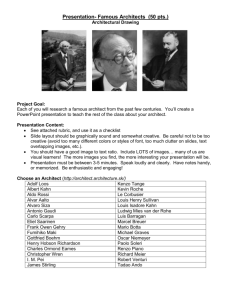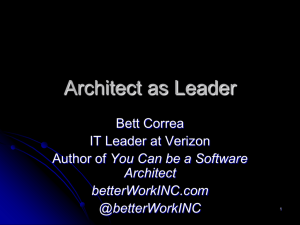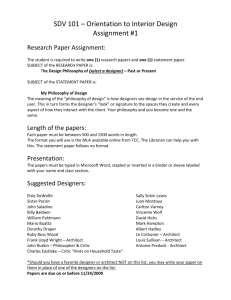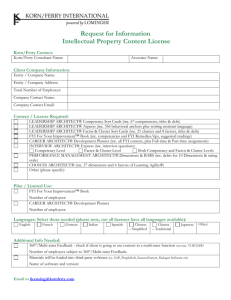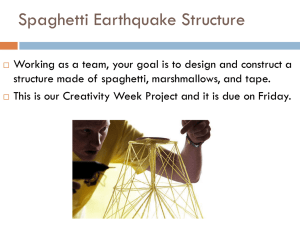Systems Architect
advertisement
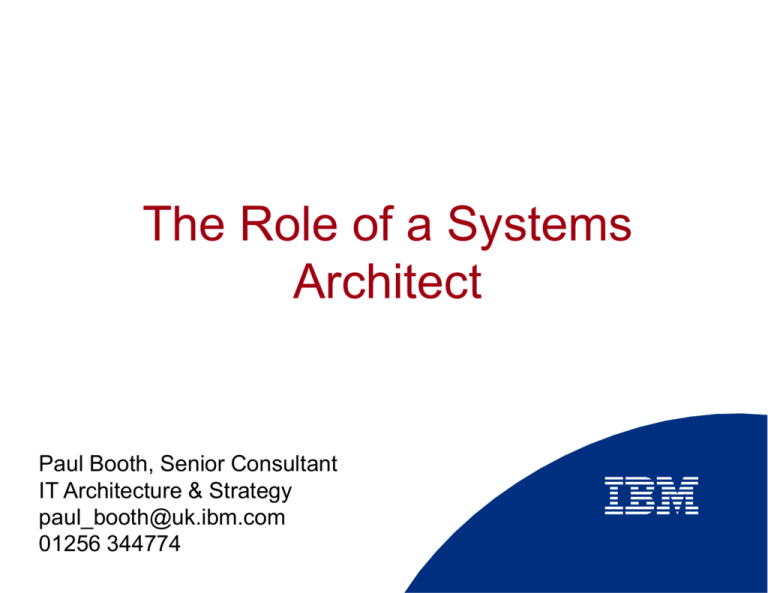
The Role of a Systems Architect Paul Booth, Senior Consultant IT Architecture & Strategy paul_booth@uk.ibm.com 01256 344774 What is a Systems Architect? The holistic approach End-to-end (holistic) Requirements-driven Requirements Analysis End-to-End Systems Architecture Viability - Non-functional Requirements Performance (response times, etc.) Availability (# breaks per year, etc.) Operability / Systems Management Security Etc. Structured Method Global Services Method Enterprise Architecture Method End-to-End Design Method SMFD (Systems Management) Availability Method Performance Engineering method The T-shaped skills profile Breadth of understanding & skill across IT Depth of technical expertise Enterprise Architecture (EA) relative to End-to-End Systems Architecture (E2E) Enterprise Strategy Data IT Strategy Architecture Process Architecture Enterprise Architecture Current Systems ABC system DEF system GHI system etc.. An Enterprise Architecture (EA) is much like a city plan in that it defines an infrastructure that will meet the current and future needs of a diverse user population and will adapt to changing business requirements and technology. Architecture Components Usage Strategy for I/T use across the enterprise City Planning Analogy City vision based on anticipated needs of residents Vision Principles Models Arch. Building Blocks Criteria Considerations for standards and product selection Standards Arch. Mgmt. Process Process to allow additions & variances to Architecture Transition Initiatives & Plan Guidance for investment and design decisions Overall context and views for systems and users Standard Components for high level design Guidelines to which systems must conform Prioritized infrastructure projects & costs Zoning and building codes to ensure quality & consistency in construction Maps and diagrams for infrastructure systems like water, sewer & electric Prefabricated building component specifications for off-site construction Considerations for component selection such as durability, cost, etc. Electrical wiring and plumbing standards Process to change the city plan and allow for variances City improvement plan Dealing with Fuzzy problems The Systems Architect Management: "I know I have a problem - it's impacting my business. But technically I don't really know where to begin." Qualify the situation Analyse background & context Define problem Recommend and plan project to handle problem Resource team with appropriate skills Carry out research Make recommendations Problem Statement or Analysis Solution Recommendations Systems Architecture situations (1) The client has.. IT-related problem The client needs.. A solution System Architect.. System Architect produces.. Defines problem Problem Analysis Report Recommends actions Problem Recommendations Outline of system solution & its feasibility Analyses & completes requirements Requirements Analysis Creates first-cut IT System Feasibility Report solution System Proposal Reviews technical feasibility Existing infrastructure Technical direction needs evolution Establishes business & technical context Technical Strategy Report Creates a recommended strategy Business requirements (possibly incomplete) Systems Architecture situations (2) The client has.. The client needs.. System Architect.. System Architect produces.. Fundamental change or increase in scale New technical Uses structured approach toEnterprise Technical Architecture to existing architecture or system create an architecture or Report, infrastructure model design Technical Infrastructure Design coming up Project with many disparate elements, Uses structured method to Technical Audit Report, or application but Overall system design review design elements and System Architecture Report, not technical create cohesive design Technical Infrastructure Design infrastructure Reviews technical design in Technical Audit / Assurance Project under way or Assurance of technical structured way. Report, in plan viability Creates systems System or Technical Architecture architecture if necessary. Systems Architecture situations (3) The client has.. Under-performing system (availability or response) Project starting The client needs.. System Architect.. System Architect produces.. Establishes where in end-toPerformance Analysis, Recommended way end system the problem Availability Analysis, forward lies. Scalability Analysis Recommends actions. To know what tasks Works with PM to create Work Breakdown Structure, required, in what order work breakdown structure Plan Benefits to the client IT Raises technical integrity of solution (i.e. it works better & offers better service to business) Increases flexibility, scalability, adaptability (etc., etc.) of system Positions IT better for business change Business Spur to creativity, innovation Reduces & manages risk Lowers cost and raises quality overall Ties IT actions more closely to business What skills do you need to do this? Understand the business requirements What does the business need? What business processes will be supported? What system components are needed to do this? Where are the business rules? Who are the key users? Who is really behind this? Understand the technology Disk (local, shared, NAS, SAN...) Windows, Unix, Linux, Solaris, z/OS, OS/400, ... DB2, Oracle, SQL Server... Java, ActiveX LANs, WANs, Routers, Firewalls RSA, SSL, Intrusion Detection -business The data Underlying data structures Tailored data groups Business Manager Tables Referential Integrity Interfacing requirements MIS requirements Imaging CLTROLE COMPANY NAME FONREF ADDRREF ADDRESS CLTDET CLTLOG CLIENT CLTTH CLIENTAS BILACT POLICY CLTACT CLTREF CLAIM PAYMNT Architectural Alternatives Gateway Java CICS Client CICS Program HUON 'E' E OS/390 for Java HT T P TC P/ ICX Client/Server or Webmodel Operational or Informational Flexibility vs. Performance OS/390 Huon Server llaweriF Network Computer or Web browser Java enabled IP HUON OS/390 for TCP/IP Go Webserver) (Lotus Domino Web server OS/390 V1R2 CICS TS for Performance MVS tuning CICS tuning DB2 tuning Efficient SQL Diagnostic tools: STROBE DB2PM EPDM OMEGAMON The operational environment The overnight schedule The data centre view of life Interfacing requirements Disaster recovery Human factors Business scripts Dialog structure Number of screens Layout of screens Drag and Drop CUA look and feel Sequence of fields Use of help Menemonics The development process Overall Development approach Tools Library management Debuggers Table data vs. code Standards and Guidelines Work activities Management systems Risk management Project deliverables Escalation procedures Roles and Responsibilities Right of Veto Sign-off criteria Testing What to test Types of test Entry criteria Exit criteria When to stop testing DEVELOPMEN T UNIT TEST INTEGRATION TEST SYSTEM TEST SINGLE THREAD VOLUME STRES SACCEPTANCE The Compleat architect A brain the size of a planet Eyes in the back of the head The memory of an elephant The armament of a tank The creativity of Salvador Dali An understanding spouse Questions ?


